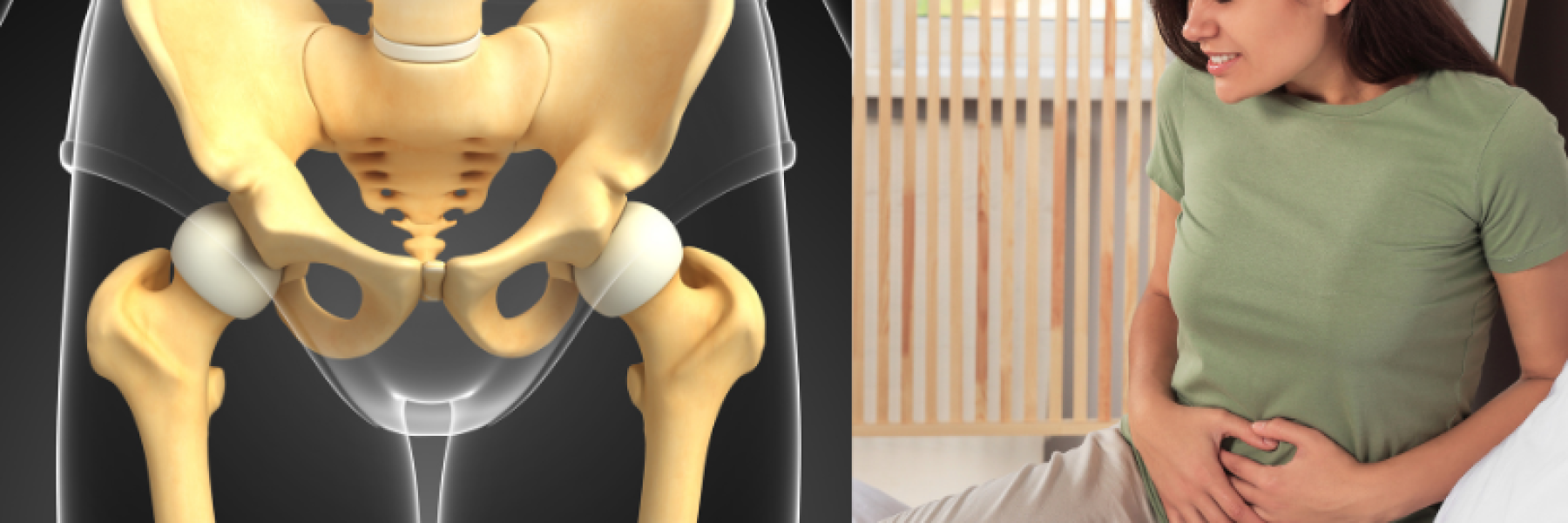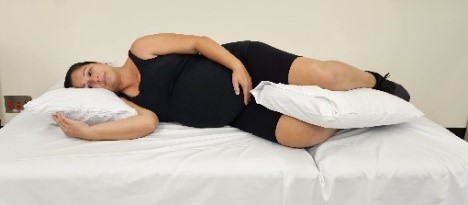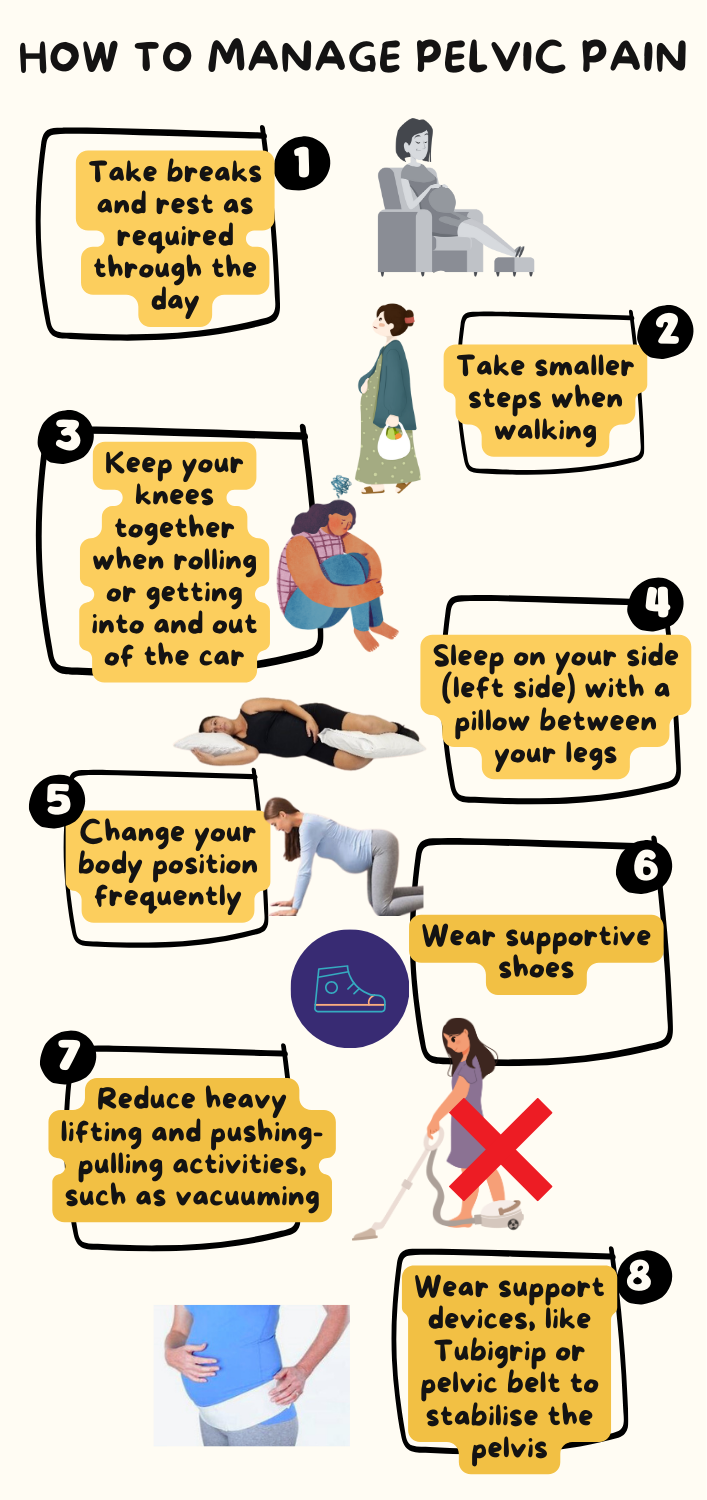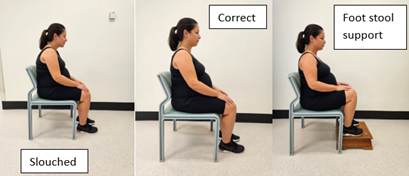
Pregnancy Related Pelvic Girdle Pain
Pregnancy related pelvic girdle pain (PPGP) is usually pain felt in the front of the pelvis (pubic symphysis) or lower back (sacroiliac joints). Pain can also be felt on one or both buttocks or in the groin. Pelvic pain usually improves naturally after birth.
What causes pelvic pain?
The exact causes are unknown, but possible mechanisms are:
- Changes to posture exerting excessive force on the joints of the pelvis, causing pain.
- Joint stability, which is the result of many contributing factors. Changes during pregnancy soften or loosen ligaments that usually function to keep the pelvic joints together in preparation for labour. This causes the joints to move which is felt as pain.
Further research is needed to confirm the proposed mechanisms above.
Activities that may increase pelvic pain
- Prolonged standing or walking (often fast walking)

- Getting in and out of the car or bed
- Rolling in bed
- Lying flat
- Going up and down stairs
- Standing on one leg
- Deep lunging or squatting

Healthy posture during pregnancy
A healthy posture decreases the chance of developing low back pain, neck pain and fatigue. Changes in posture are common during pregnancy due to hormonal changes and foetal growth. The following guide aims to help you maintain a healthy posture during pregnancy:
Sitting
✔ Ensure the length of your thighs are supported by the chair
✔ Keep your knees level with your hips.
✔ Use a foot stool if required
✔ Limit prolonged sitting in one position
✘ Do not slouch
✘ Do not cross your legs
Standing and Walking
✔ Contract your abdominal muscles and buttocks when standing from a chair, prior to lifting objects.
✔ Take smaller steps when walking and limit prolonged standing.
✔ If you experience pain with everyday activities, consider using supportive garments.
✘ Do not over tilt your pelvis/ over-arch your back (as pictured)
Useful Contacts
Liverpool Hospital
Women’s, Men’s and Pelvic Health Physiotherapy Department
Level 2 Health Service Building
Corner Goulburn & Campbell St
Liverpool 2170
Ph: 8738 4703 or 87384707
Monday to Friday 8 am to 4:30 pm excluding Public Holidays
Email: SWSLHD-LiverpoolPhysiotherapyReferrals@health.nsw.gov.au
Fairfield Hospital
Women’s, Men’s and Pelvic Health Physiotherapy Department
Level 1
Corner Prairievale Rd & Polding St
Prairiewood NSW 2170
Phone: 9616 8324
Fax: 9616 8537
Monday to Friday 8 am to 4:30 pm excluding Public Holidays
Email: SWSLHD-FairfieldPhysioReferral@health.nsw.gov.au
Bankstown Hospital
Outpatient Physiotherapy Department
Allied Health Building
68 Elridge Rd, Bankstown 2200
Phone: 97227150
Fax: 97227125
Monday to Friday 8am to 4:30pm excluding public holidays
Email: SWSLHD-Bankstown-PhysiotherapyOPD@health.nsw.gov.au
Campbelltown Hospital
Allied Health Outpatients – Physiotherapy
Building D, Ground Floor
Parkside Crescent
Campbelltown 2560
Ph: (02) 4634 4794 | Fax: (02) 4634 3895
Monday to Friday 8:00am to 4:30pm excluding Public Holidays
Email: CampbelltownPhysiotherapy@health.nsw.gov.au
Bowral & District Hospital
Outpatient Physiotherapy Department
Watson Building
Bowral Street & Mona Road
Bowral NSW 2576
Ph: 4861 0298
Fax: 4861 0251
Monday to Friday 8 am to 4:30 pm excluding Public Holidays
Related Topics

The are some nutrients that are recommended to supplement during pregnancy...

